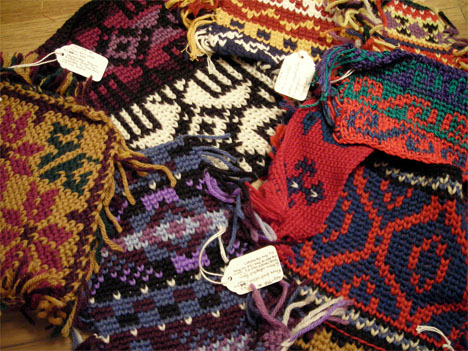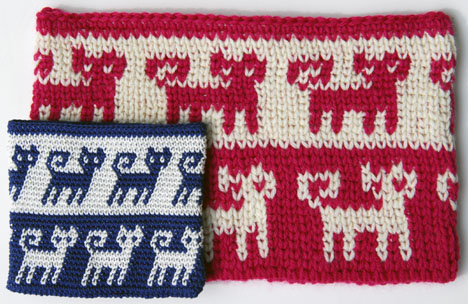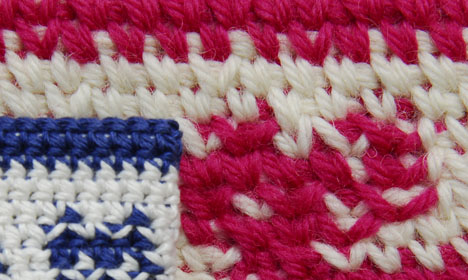According to Ariana, “The finished project does not behave like knitting – structurally it’s still single crochet, but the look is nice. It is actually a little firmer than regular single crochet, as you are working into the stitch below a little . . . deeper, I guess you could say. I think that’s why they call it ‘shallow crochet’, because you don’t actually gain as much height with each round as you would with a round of regular single crochet. It has a firmness that’s great for jackets, purses, pillows – with a finer yarn, like sportweight or sockweight you get a fabric than behaves like . . . maybe light denim. Shallow stitch has a significant bias and has to be wet-blocked to be straight, so I like to use a fibre that can be blocked – a wool or a cotton rather than acrylic.”
“I often do tapestry crochet using a ‘shallow single crochet’ usually abbreviated in patterns as ssc. Instead of working your single crochet into the top two loops of the stitch below, put your hook in the centre of the stitch below, between the two uprights. You have to work this stitch in one direction only so you always have the right side facing. The result is the perfectly stacked little “V” shapes of knitting.”
After Ariana shared her swatches with the Ravelry Tapestry Crochet Group, I began to experiment, too. Several attempts were required to successfully produce the red and white sample below – done with a large hook, loose tension, and stretchy yarn.
The motifs on my sample didn’t slant – maybe because the hook was stuck under the carried yarn of the stitch below.
I’m not only intrigued by the look of the front and back – but also by the incredible thickness of the fabric! To me, it looks like shallow single tapestry crochet has great potential!



Hi Carol,
I was at Amazon and discovered a book (out of print) but available used titled Hard Crochet by Matt Dittrick.
Apparently you both need to get your books published again. Fantastic stuff.
All the best,
Ann
Hi Carol,
That looks like Knit Stitch in Tunisian Crochet, done without the back and forth! How cool!
Kathryn
Wow, as Kathryn says, that looks a lot like doing tapestry with Tunisian Knit, but without the constant thread changes that make Tunisian tapestry rather… cumbersome to do.
Unlike Tunisian, only one stitch is worked at a time. It takes a lot of practice to get used to this technique, though!
if I am to work only on one side, the right side, then I would have lots of ends to work in. Is there a way to get around that? Or do I have to crochet backwardds on every second row?
Manya
I encase the carried colors in the single crochet stitches, so I have no ends. I crochet backwards on every other row when I crochet back and forth to eliminate the ridge formed when it’s crocheted normally back and forth.
I tried to figure out and work this stitch to no avail. I have lots of resistence if I’m doing it right. So I don’t think it’s possible. It seems like I’m working over the stitch in the row below, the last row worked. I don’t remember what it’s called but I sometimes do a stitch where I go into part of the present stitch and part into the stitch of the previous row and I get a stiffer material, with less height than a regular single crochet. Do you have a tutorial with pictures of this stitch. I think that’s probably what’s needed if I’m to succeed here.
Perhaps your stitches are too tight. Try to crochet more loosely so that the hook can go more easily into the stitch. Also, try to do it without carrying the other color, then carry the color once you can do the stitch.